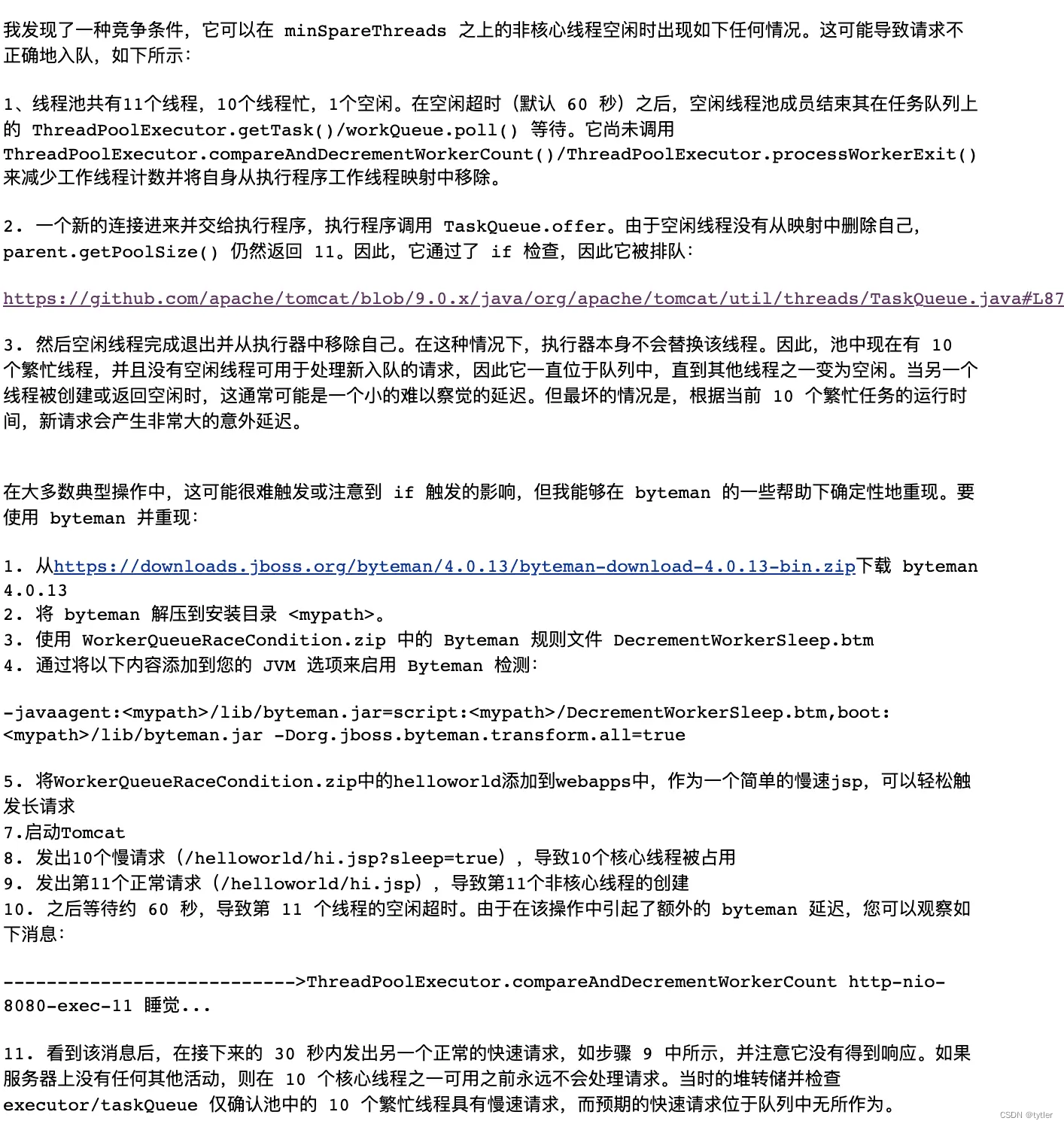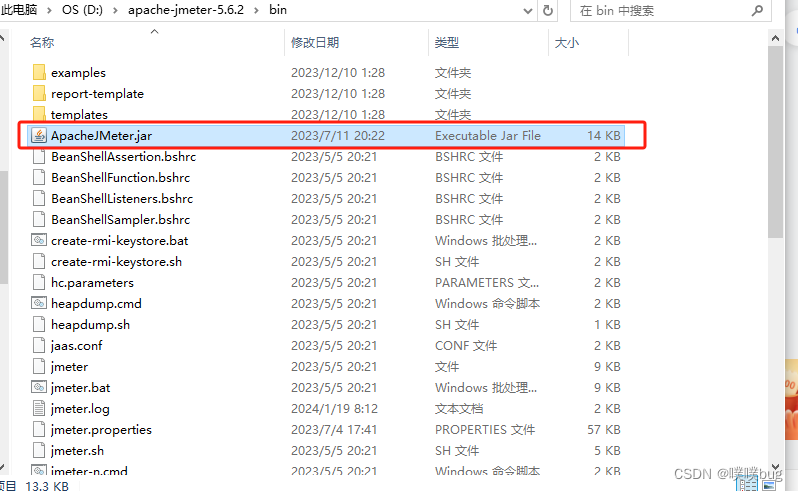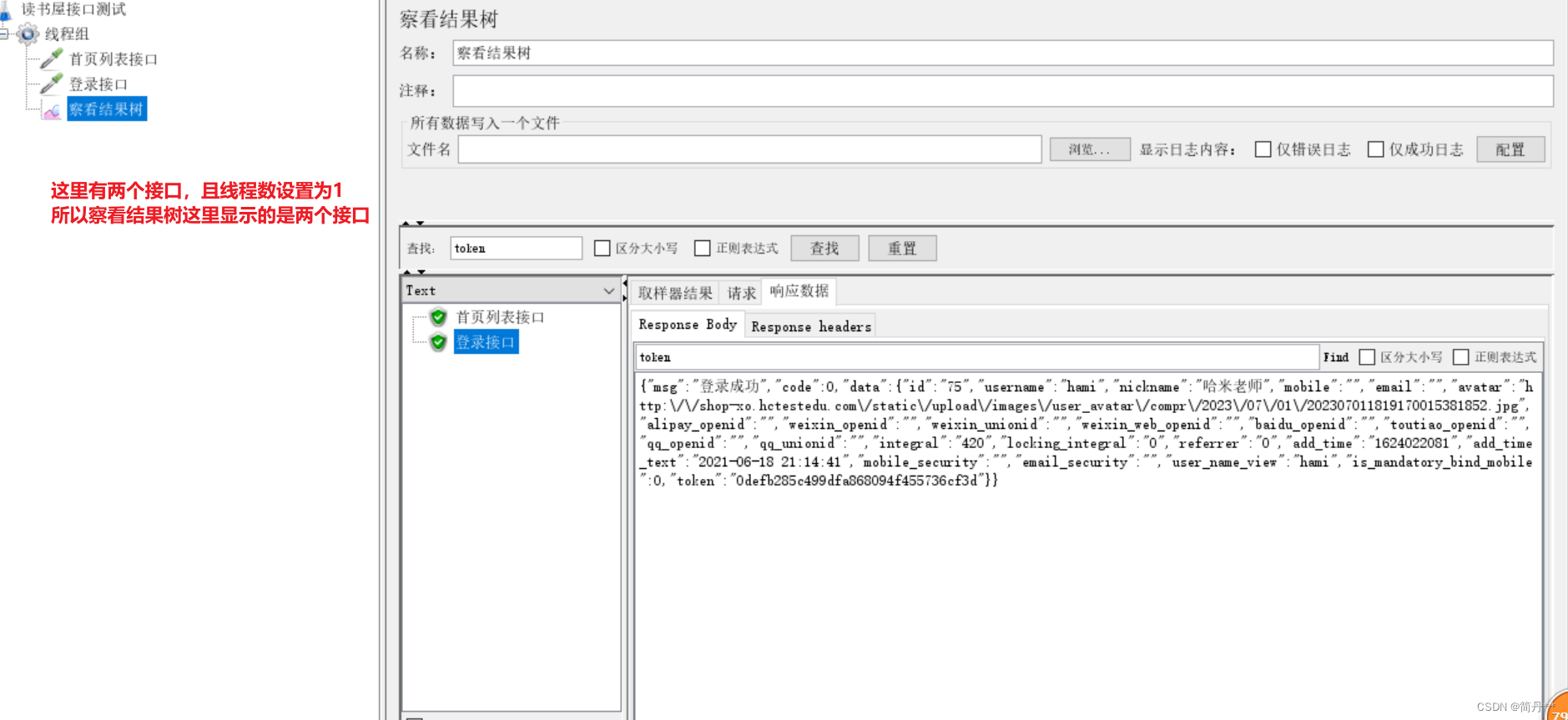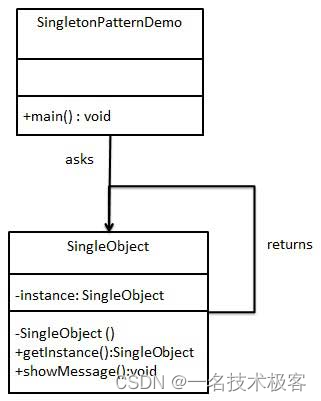1.1 tomcat线程池和juc线程池流程
jdk 线程池策略:
- 当线程池中线程数量小于 corePoolSize,每来一个任务,就会创建一个线程执行这个任务
- 当前线程池线程数量大于等于 corePoolSize,则每来一个任务,会尝试将其添加到任务缓存队列中;若是添加成功,则该任务会等待线程将其取出去执行;若添加失败(一般来说任务缓存队列已满),则会尝试创建新的线程执行
- 当前线程池线程数量等于 maximumPoolSize,则会采取任务拒绝策略进行处理
tomcat 线程池策略:
- 当前线程数小于 corePoolSize,则去创建工作线程
- 当前线程数大于 corePoolSize,但小于 maximumPoolSize,则去创建工作线程
- 当前线程数大于 maximumPoolSize,则将任务放入到阻塞队列中,当阻塞队列满了之后,则调用拒绝策略丢弃任务
1.2 tomcat线程池和juc线程池的区别
tomcat 线程池是在 juc线程池的基础上,修改少量代码来实现,tomcat 线程池执行流程和 juc的线程池执行流程有着很大的区别,那么tomcat为什么要这样设计?
使用线程池的任务有两种:
-
CPU 密集型任务
-
Tomcat 若使用原生的JDK线程池,一旦接收的请求数量大于线程池的核心线程数,这些请求就会被放到队列中,等待核心线程处理,这样会降低请求的总体处理速度,所以 Tomcat并没有使用JDK原生线程池的策略 (例如:10个核心线程,20个最大线程,15个请求过来的时候,有5个请求放入队列进行等待处理,这也是为什么 tomcat 要使 work 线程优先 queue的原因)
-
JDK线程池:当线程数达到 corePoolSize 后,任务首先被放到 queue,发挥CPU多核的并行优势,减少多个线程导致的上下文切换,适合的场景是:CPU密集型任务
-
Tomcat线程池:当大量请求达到时,接收的请求数量大于核心线程池的 corePoolSize 时,会继续创建 worker 线程去处理请求,而后续请求量变少时,只会销毁 maximumPoolSize 线程数,适合的场景是:IO密集型
1.3 IO密集型和CPU密集型任务核心参数的设置
-
线程数过多问题的解决方案:指定 ThreadPoolExecutor 的 allowCoreThreadTimeout=true,那么核心线程若处于闲置状态的话,超过一定的时间(KeepAliveTime),就会销毁掉
-
引入问题:当核心线程数被销毁时,而有大量请求到达时系统重新创建 worker 线程,会使得前期接口响应时间变长(这也是为什么系统上线需要预热)
Tomcat线程池执行流程
-
思想:主要流程还是JDK线程池流程,即先开启 corePoolSize 线程,然后在 queue,最后在开启 maximumPoolSize 线程,Tomcat 重点改造的是 queue 的 offer(),即在向 queue 放入任务时,若发现未达到最大线程数,那么 offer() 返回 false,即放入队列失败,此时,便继续开启 maximumPoolSize 线程
自定义队列
/**
* 实现Tomcat特有逻辑的自定义队列
*/
public class TaskQueue extends LinkedBlockingQueue<Runnable> {
private static final long serialVersionUID = 1L;
private transient volatile ThreadPoolExecutor parent = null;
private static final int DEFAULT_FORCED_REMAINING_CAPACITY = -1;
/**
* 强制遗留的容量
*/
private int forcedRemainingCapacity = -1;
/**
* 队列的构建方法
*/
public TaskQueue() {
}
public TaskQueue(int capacity) {
super(capacity);
}
public TaskQueue(Collection<? extends Runnable> c) {
super(c);
}
/**
* 设置核心变量
*/
public void setParent(ThreadPoolExecutor parent) {
this.parent = parent;
}
/**
* put:向阻塞队列填充元素,当阻塞队列满了之后,put时会被阻塞。
* offer:向阻塞队列填充元素,当阻塞队列满了之后,offer会返回false。
*
* @param o 当任务被拒绝后,继续强制的放入到线程池中
* @return 向阻塞队列塞任务,当阻塞队列满了之后,offer会返回false。
*/
public boolean force(Runnable o) {
if (parent == null || parent.isShutdown()) {
throw new RejectedExecutionException("taskQueue.notRunning");
}
return super.offer(o);
}
/**
* 带有阻塞时间的塞任务
*/
@Deprecated
public boolean force(Runnable o, long timeout, TimeUnit unit) throws InterruptedException {
if (parent == null || parent.isShutdown()) {
throw new RejectedExecutionException("taskQueue.notRunning");
}
return super.offer(o, timeout, unit); //forces the item onto the queue, to be used if the task is rejected
}
/**
* 当线程真正不够用时,优先是开启线程(直至最大线程),其次才是向队列填充任务。
*
* @param runnable 任务
* @return false 表示向队列中添加任务失败,
*/
@Override
public boolean offer(Runnable runnable) {
if (parent == null) {
return super.offer(runnable);
}
//若是达到最大线程数,进队列。
if (parent.getPoolSize() == parent.getMaximumPoolSize()) {
return super.offer(runnable);
}
//当前活跃线程为10个,但是只有8个任务在执行,于是,直接进队列。
if (parent.getSubmittedCount() < (parent.getPoolSize())) {
return super.offer(runnable);
}
//当前线程数小于最大线程数,那么直接返回false,去创建最大线程
if (parent.getPoolSize() < parent.getMaximumPoolSize()) {
return false;
}
//否则的话,将任务放入到队列中
return super.offer(runnable);
}
/**
* 获取任务
*/
@Override
public Runnable poll(long timeout, TimeUnit unit) throws InterruptedException {
Runnable runnable = super.poll(timeout, unit);
//取任务超时,会停止当前线程,来避免内存泄露
if (runnable == null && parent != null) {
parent.stopCurrentThreadIfNeeded();
}
return runnable;
}
/**
* 阻塞式的获取任务,可能返回null。
*/
@Override
public Runnable take() throws InterruptedException {
//当前线程应当被终止的情况下:
if (parent != null && parent.currentThreadShouldBeStopped()) {
long keepAliveTime = parent.getKeepAliveTime(TimeUnit.MILLISECONDS);
return poll(keepAliveTime, TimeUnit.MILLISECONDS);
}
return super.take();
}
/**
* 返回队列的剩余容量
*/
@Override
public int remainingCapacity() {
if (forcedRemainingCapacity > DEFAULT_FORCED_REMAINING_CAPACITY) {
return forcedRemainingCapacity;
}
return super.remainingCapacity();
}
/**
* 强制设置剩余容量
*/
public void setForcedRemainingCapacity(int forcedRemainingCapacity) {
this.forcedRemainingCapacity = forcedRemainingCapacity;
}
/**
* 重置剩余容量
*/
void resetForcedRemainingCapacity() {
this.forcedRemainingCapacity = DEFAULT_FORCED_REMAINING_CAPACITY;
}
}
2.2 自定义线程池ThreadPoolExecutor
Tomcat 线程池 ThreadPoolExecutor 是继承的 AbstractExecutorService 类,但是很多代码依旧使用的是 JDK 的 ThreadPoolExecutor,只是稍微改造了一部分
public void execute(Runnable command, long timeout, TimeUnit unit) {
/**
* 提交任务的数量+1
*/
submittedCount.incrementAndGet();
try {
/**
* 线程池内部方法,真正执行的方法。就是JDK线程池原生的方法。
*
* 因为重写了阻塞队列,才完成Tomcat特有逻辑的实现。
*
* 1. 重写队列方法;达到核心线程数,然后向阻塞队列中放置,阻塞队列直接返回false
* 2. 返回false,则开启maximum pool size;
* 3. maximum pool size到达极限时,会抛出RejectedExecutionException方法。
*
*/
executeInternal(command);
/**
* 任务被拒绝
*/
} catch (RejectedExecutionException rx) {
/**
* 在将被拒绝的任务放入到队列中。
*/
if (getQueue() instanceof TaskQueue) {
//如果Executor接近最大线程数,应该将任务添加到队列中,而不是拒绝。
final TaskQueue queue = (TaskQueue) getQueue();
try {
//强制的将任务放入到阻塞队列中
if (!queue.force(command, timeout, unit)) {
//放入失败,则继续抛出异常
submittedCount.decrementAndGet();
throw new RejectedExecutionException("threadPoolExecutor.queueFull");
}
} catch (InterruptedException x) {
//被中断也抛出异常
submittedCount.decrementAndGet();
throw new RejectedExecutionException(x);
}
} else {
//不是这种队列,那么当任务满了之后,直接抛出去。
submittedCount.decrementAndGet();
throw rx;
}
}
}
/**
* JDK线程池的任务执行的逻辑
*/
private void executeInternal(Runnable command) {
if (command == null) {
throw new NullPointerException();
}
int c = ctl.get();
//未达到corePoolSize数量,则去开启线程
if (workerCountOf(c) < corePoolSize) {
if (addWorker(command, true)) {
return;
}
c = ctl.get();
}
//开启到corePoolSize数量的工作线程,则将任务放入队列。
//但是Tomcat重写了阻塞队列。
//当放入workQueue.offer(command)返回false,则继续开启线程数
if (isRunning(c) && workQueue.offer(command)) {
int recheck = ctl.get();
if (!isRunning(recheck) && remove(command)) {
reject(command);
} else if (workerCountOf(recheck) == 0) {
addWorker(null, false);
}
} else if (!addWorker(command, false)) {
//开启最大线程失败,则任务被拒绝。
reject(command);
}
}
注意事项

private void processWorkerExit(Worker w, boolean completedAbruptly) {
if (completedAbruptly) {
decrementWorkerCount();
}
final ReentrantLock mainLock = this.mainLock;
mainLock.lock();
try {
completedTaskCount += w.completedTasks;
workers.remove(w);
} finally {
mainLock.unlock();
}
tryTerminate();
int c = ctl.get();
if (runStateLessThan(c, STOP)) {
if (!completedAbruptly) {
//获取剩余的最小线程数,若配置了允许最小线程数关闭的参数,min=0
int min = allowCoreThreadTimeOut ? 0 : corePoolSize;
//当配置了允许最小线程关闭参数,且队列不为空的情况下,允许保留的最小线程数为1
/**
* 这是关闭空闲核心线程数时的判断。
*/
if (min == 0 && !workQueue.isEmpty()) {
min = 1;
}
// https://bz.apache.org/bugzilla/show_bug.cgi?id=65454
// If the work queue is not empty, it is likely that a task was
// added to the work queue between this thread timing out and
// the worker count being decremented a few lines above this
// comment. In this case, create a replacement worker so that
// the task isn't held in the queue waiting for one of the other
// workers to finish.
/**
* 若当前工作数量>允许的最小线程数,那么关闭改线程。
* Tomcat对此处进行了优化。
*/
if (workerCountOf(c) >= min && workQueue.isEmpty()) {
return; // replacement not needed
}
}
/**
* 没有终止线程,又重新开启线程
*/
addWorker(null, false);
}
}
原文地址:https://blog.csdn.net/qq_41956014/article/details/131141941
本文来自互联网用户投稿,该文观点仅代表作者本人,不代表本站立场。本站仅提供信息存储空间服务,不拥有所有权,不承担相关法律责任。
如若转载,请注明出处:http://www.7code.cn/show_13079.html
如若内容造成侵权/违法违规/事实不符,请联系代码007邮箱:suwngjj01@126.com进行投诉反馈,一经查实,立即删除!







